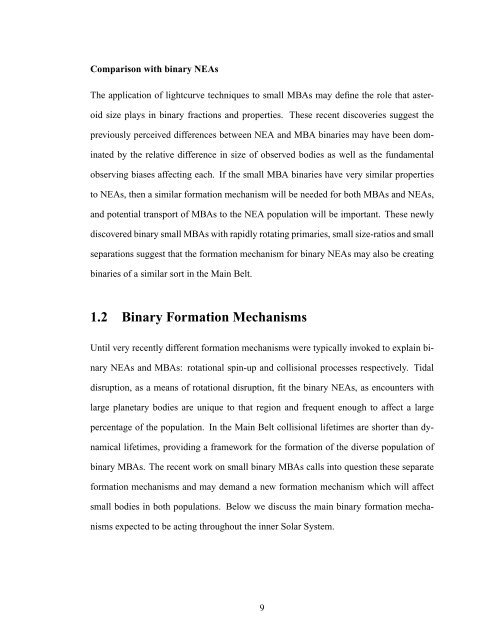Forming Binary Near-Earth Asteroids From Tidal Disruptions
Forming Binary Near-Earth Asteroids From Tidal Disruptions
Forming Binary Near-Earth Asteroids From Tidal Disruptions
Create successful ePaper yourself
Turn your PDF publications into a flip-book with our unique Google optimized e-Paper software.
Comparison with binary NEAsThe application of lightcurve techniques to small MBAs may define the role that asteroidsize plays in binary fractions and properties. These recent discoveries suggest thepreviously perceived differences between NEA and MBA binaries may have been dominatedby the relative difference in size of observed bodies as well as the fundamentalobserving biases affecting each. If the small MBA binaries have very similar propertiesto NEAs, then a similar formation mechanism will be needed for both MBAs and NEAs,and potential transport of MBAs to the NEA population will be important. These newlydiscovered binary small MBAs with rapidly rotating primaries, small size-ratios and smallseparations suggest that the formation mechanism for binary NEAs may also be creatingbinaries of a similar sort in the Main Belt.1.2 <strong>Binary</strong> Formation MechanismsUntil very recently different formation mechanisms were typically invoked to explain binaryNEAs and MBAs: rotational spin-up and collisional processes respectively. <strong>Tidal</strong>disruption, as a means of rotational disruption, fit the binary NEAs, as encounters withlarge planetary bodies are unique to that region and frequent enough to affect a largepercentage of the population. In the Main Belt collisional lifetimes are shorter than dynamicallifetimes, providing a framework for the formation of the diverse population ofbinary MBAs. The recent work on small binary MBAs calls into question these separateformation mechanisms and may demand a new formation mechanism which will affectsmall bodies in both populations. Below we discuss the main binary formation mechanismsexpected to be acting throughout the inner Solar System.9












